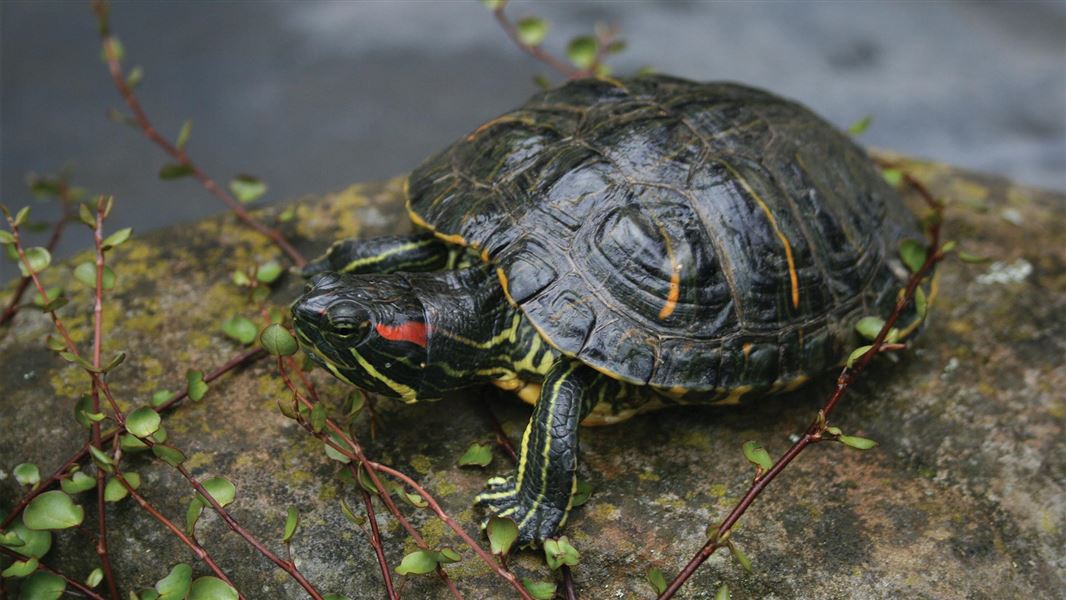Archived content: This media release was accurate on the date of publication.
Date: 25 September 2024
DOC freshwater ranger Matt Brady says red-eared slider turtles brumate during winter, meaning they’re sluggish and don’t eat for weeks at a time.
“Brumation is like a half hibernation. When red-eared sliders emerge in spring, looking for food, they’re a serious threat to native freshwater plants and animals.”
Matt says Aotearoa doesn’t have native freshwater turtles so any turtle seen in the wild is an escaped exotic species.
“Red-eared slider turtles can be kept as pets throughout much of the country, but if abandoned, they’re a problem.”
Volunteer leader Jayne Nightingale and a team of volunteers have caught 76 red-eared slider turtles at Cook’s Beach, Coromandel, since 2021. These include turtles caught in a trap provided by Waikato Regional Council as well as those handed in by the community or as bycatch in fishing gear.
“When I first started trapping turtles, I was met with a lot of negativity from the locals. However, with a bit of education, the ecological impacts from invasive turtles have become much better understood.
“The trapping work has been so successful that we think only a couple of the turtles remain at large. We hope to catch them this spring, when they’re more active,” says Jayne.
Matt says the best thing people can do protect native ecosystem from turtles is to report them.
“If you see a turtle in the wild, take a photo and record it on iNaturalist or the Find-A-Pest app. This helps DOC and regional councils to understand where the turtles are, how many there are, and it informs how we manage them.”
If the turtle looks sick, injured or in need of urgent care, contact your local vet or SPCA. If it is safe, put the turtle in a container with wet towels and keep it at home in a cool place until advised what to do next by the SPCA or vet. Take care as turtles can bite.
If you’re struggling to look after your pet turtle, contact the SPCA to find out how they could support you.
Matt also asks anyone considering buying a red-eared slider turtle to do their ‘due diligence’.
“Red-eared sliders can grow to the size of a dinner plate and live for up to 50 years. They have particular habitat needs such as large, heated aquarium or a secure outdoor pond. Taking on a turtle requires 100% commitment.”
Background information
Red-eared slider turtles are native to North America. They can be kept as pets in Aotearoa New Zealand, but are banned from sale in Auckland.
They have an olive green to brown shell patterned with yellow spots or stripes, and a distinctive red stripe behind their eyes. The ‘slider’ part of their name comes from their ability to slide into the water quickly from rocks and logs.
Turtle eggs have to remain at 22–33°C for 55–80 days to hatch into live young. At cooler temperatures, only male turtles are produced. In warmer parts of Aotearoa, turtle eggs can hatch but do not produce female young.
As climate change brings increased temperatures, there is concern that both male and female young will hatch and allow a self-sustaining population to establish in the wild.
Red-eared sliders are listed by the IUCN as one of the 100 worst invasive species. They are regarded as invasive because they damage freshwater ecosystems. In Aotearoa New Zealand, they eat fish, plants, aquatic insects, koura, and small birds including ducklings. Red-eared sliders can also displace wetland bird nesting sites. Their presence in a waterway can reduce water quality.
Releasing turtles into the wild is an offence under the Biosecurity Act and the Animal Welfare Act, and in some regions would breach Regional Pest Management Plans. You could face a fine of $5,000.
Contact
For media enquiries contact:
Email: media@doc.govt.nz
